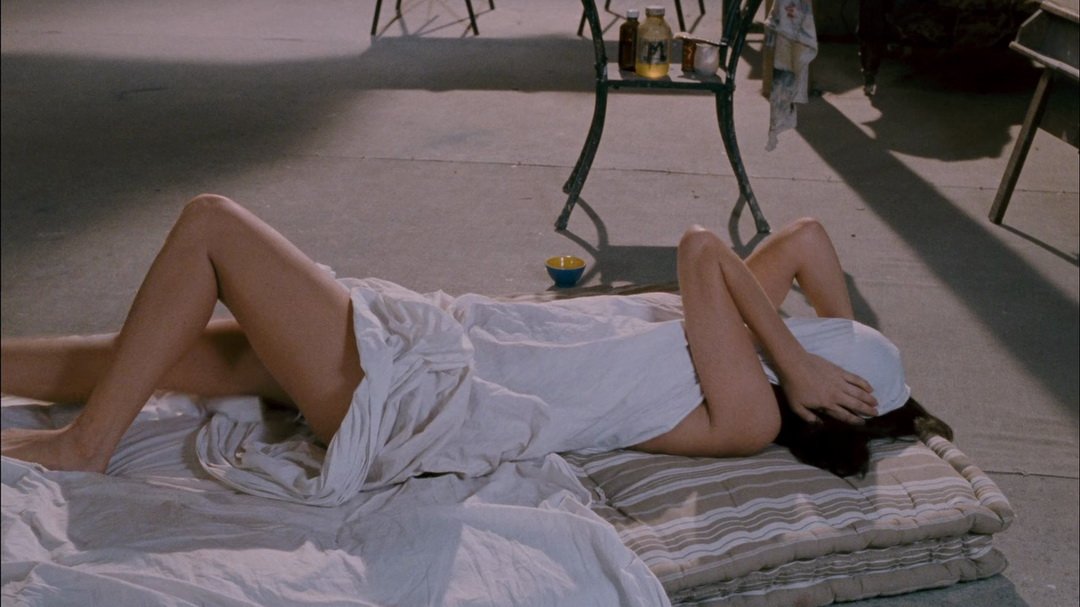Phuong Presses Play: Movies For Sleeping
The thing about insomnia is it gives you (me) main character syndrome. My chronic sleeping problems encourage me to operate under the delusion that, just because I am awake when most people in my time zone are not, I am somehow privileged to thrive in an alternate reality where my every action—be it writing or staring out the window at 2 in the morning—acquires a clandestine poignancy. While I can be very productive during the night, I also revel in sheer sleepless idleness, enabled by the release from daytime decorum of productivity and human speech. Having always lived in big cities, I find comfort in their nocturnal silence and mystery, occasionally ruptured by the revving of the odd passing cars.
Still, with each passing year, my blasé attitude about my sleeping patterns has become quite unsustainable. At the urging of friends, family, and my speedily deteriorating body, I have tried every remedy that nature and science have to offer, from lotus seed tea, yoga, to melatonin. And so, like in many other chapters in my life, cinema comes to the rescue.
The relationship between sleep, dreams, and cinema has been rigorously theorized. However, when I choose a movie to fall asleep to, I seek, not Technicolor reveries, but comfort. Insomnia makes me acutely alert to the passing of time. Regardless of how I’m used to being wakeful, every passing second feels like a kind of waste, as my body is so ideologically wired to equate the lulls in time with uselessness. Consequently, films that dwell on duration, by their virtue of unhurriedly mining the grains of time passed, always manage to relieve such worries from my psyche. By setting my eyes on long takes and static compositions, my experience of “real” time is supplanted by the presence of filmic time.
Chantal Akerman’s movies—my go-to for sleepless nights—are especially great at inducing this effect. Since her films eschew causal impulses and refuse to neatly weave themselves into a rigid plot structure, my brain also ceases to look at the act of falling asleep as a series of procedural steps. It is fine that sleep does not automatically follow my getting into bed and pulling the blanket up to my neck. It will come when it comes.
Another one of my sleep aids is movies that traverse in repetitions, both visually and sonically. In watching these films, my restlessness is sapped by the reassuring constant of recurring motifs and images. The TV version of Ingmar Bergman’s Scenes from a Marriage exemplifies my weird comfort in films where people argue in a language I do not understand. Regardless of whether I doze off or suddenly rouse, Liv Ullmann and Erland Josephson will still be bickering for eternity.
During the first lockdown when my sleep schedule got even more chaotic—I would go to bed at 7 am and wake up at noon—my equilibrium was finally restored by Jacques Rivette’s 4-hour-long La Belle Noiseuse, which I revisited every night for about a month after my first watch. This strangely restorative film satisfies my criteria for excellent slumber cinema. Full of pleasurable recurring images, the film also concretizes time passages.
Based on a Balzac short story, the plot of La Belle Noiseuse is deceptively simple. While vacationing in the south of France, Marianne (Emmanuelle Béart), a writer, is introduced by her artist boyfriend Nicolas (David Bursztein) to his idol, aged painter Edouard Frenhofer (Michel Piccoli). The encounter is quietly staggering. The presence of the youthful couple appears to disturb the tranquility of Frenhofer’s grand chateau, stirring in the old maestro the desire to revisit a painting titled “La Belle Noiseuse”—or “The Beautiful Troublemaker”—that he abandoned a decade ago. Originally modeled after his partner Liz (Jane Birkin), the portrait finds its new muse in Marianne, whose initially reluctant participation is facilitated by Nicolas. Like a pebble thrown onto a placid lake, the sittings send violent ripples, not only across a tangle of romantic relationships, but also within the characters’ emotional interiority.
Unlike other films about artists where the final result constitutes the locus of the spectacle, La Belle Noiseuse foregrounds the aural and physical tactility of the creative process itself. The film leisurely documents Frenhofer’s laborious sketches of a nude Marianne in unhurried long takes. The camera patiently lingers on close-ups of the maestro’s hands—which belong to Bernard Dufour who did the paintings seen in the film—as they hover over blank pages where inky strokes gradually cohere into the female form. Against the solemn silence of Frenhofer’s studio, separately situated from the main living quarters like a kind of chapel, the sensitive, ASMR soundscape of brushes sweeping over papers or charcoal etching on canvases lulls me into a state of relaxation. In the first two sittings, save for the occasional posing direction, words cease to be of importance. All that exists between Frenhofer and Marianne is the physicality of perceiving and being perceived. My nocturnal racing thoughts are drowned out by the film’s demand of me to experience time, not as an abstract entity, but as embodied in minute, bodily gestures. La Belle Noiseuse is undoubtedly an intellectually rich film, yet when I submerge myself in these painting sequences, the interplay between the long take and the emphasis on the aural and visual materialization of human forms compels me to put my critical brain in park mode, and instead organically absorb the sheer pictorial quality of the mise en scène.
The process of starting and finishing an artwork also strangely resembles the liminal period between waking and sleeping. For an insomniac, falling asleep feels like finally solving a riddle. It makes me think of Julio Cortázar, who once compared writing to the act of decanting. After pouring his obsessions onto the blank pages, the writer is exorcised, freed. When I toss and turn in my bed, the seemingly unsolvable issue of falling asleep often mirrors a tortuous emptying of thoughts. Is Frenhofer pouring out his decades-long preoccupations onto the canvas too? When he finishes the promised masterpiece, will it also feel like rest, a closing of the eyes in recognition of a deed well executed?
Yet, unlike the solitary work of a writer, Frenhofer is confronted with the agency of another living, breathing human being. The dynamic between the muse and the artist is another source of the film’s many pleasures. Interestingly enough, the first two sittings deceptively affirm the tacit archetype of the egoistic male artist, for Frenhofer directs, verbally and physically, Marianne’s form into specific, agonizing poses. As the young woman crouches on the floor, strenuously stretches across a hard bench, or simply stands still, Frenhofer carefully straightens her back, or bends her arms according to his will. Marianne protests, but she also obeys. However, this is far from mindless submission. Since Marianne’s headstrong nature is evident in her petulant pouts and darting gazes, her acquiescence to these rigid positions implicitly speaks to a shared trust. In fact, her faith in this creative process would grow stronger than the painter’s own belief in his ability to carry this lofty endeavor to fruition.
Frenhofer’s most consummate sparks of inspiration occur when Marianne finally fights back, as she brusquely disturbs the tranquil sanctum of the well-lit studio, rearranging the furniture and plopping herself on a floor mattress in her freely chosen poses. In unsettling the immovable gaze that Frenhofer imposes upon her image, Marianne reasserts her status, not as a mere object to be visually dissected and analyzed, but rather a participatory subject in Frenhofer’s struggle against creative slumps. The moment Marianne opens up about her romantic doubts and adolescent nightmares while lying curled up on the floor mattress like a worn-out child, Frenhofer is jolted into a renewed resolve. The distance between the artist and the model is effaced, and the exchange of spiritual and physical energy—like Marianne rolling around while Frenhofer falls off a chair—coalesces into a bond that encompasses gender and age difference.
When Frenhofer finally completes the painting, it is difficult to say whether the artwork arises from a cumulation of unceasing sketches or these sudden sparks of creative outburst. Still, the answer seems beside the point. La Belle Noiseuse is more interested in the process of becoming. A painting coming into its own being. A mass of flesh and neurosis turned into lines and dabs where what’s visible on the page must have held a dose of authenticity. In the end, Frenhofer startlingly wedges the finished La Belle Noiseuse, which has only been seen by Marianne and Liz, into a hollow in the wall of his studio. All that’s visible to viewers is a patch of red paint; the work itself remains a scarlet secret.
During my rituals of rewatching the film every night, I only ever revisited the scenes of the sittings. The transformative nature of these sequences where the quotidian and the sublime are intermingled lifted me into a different state of consciousness. In “Everything” by Frederick Seidel, my favorite poem about cinema, these lines perfectly capture the phenomenology of watching a movie:
I like the speed
And the incomparably blurred
Sensation of being deformed
Into being and about to begin.
When it comes to falling asleep normally, I am already deformed. Watching La Belle Noiseuse evokes a reversal of this sentiment, wherein the film makes me feel whole. It relaxes my posture, calms my mind, puts every bit of myself into a restful totality, and sees me off to slumberland.




